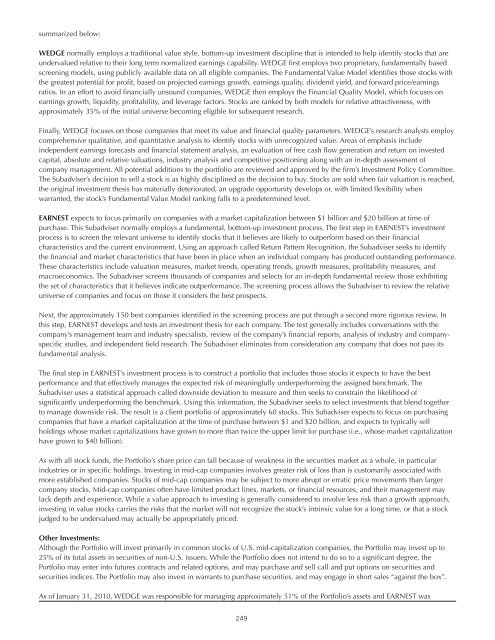Advanced Series Trust AST Academic Strategies Asset ... - Prudential
Advanced Series Trust AST Academic Strategies Asset ... - Prudential
Advanced Series Trust AST Academic Strategies Asset ... - Prudential
Create successful ePaper yourself
Turn your PDF publications into a flip-book with our unique Google optimized e-Paper software.
summarized below:<br />
WEDGE normally employs a traditional value style, bottom-up investment discipline that is intended to help identify stocks that are<br />
undervalued relative to their long term normalized earnings capability. WEDGE first employs two proprietary, fundamentally based<br />
screening models, using publicly available data on all eligible companies. The Fundamental Value Model identifies those stocks with<br />
the greatest potential for profit, based on projected earnings growth, earnings quality, dividend yield, and forward price/earnings<br />
ratios. In an effort to avoid financially unsound companies, WEDGE then employs the Financial Quality Model, which focuses on<br />
earnings growth, liquidity, profitability, and leverage factors. Stocks are ranked by both models for relative attractiveness, with<br />
approximately 35% of the initial universe becoming eligible for subsequent research.<br />
Finally, WEDGE focuses on those companies that meet its value and financial quality parameters. WEDGE’s research analysts employ<br />
comprehensive qualitative, and quantitative analysis to identify stocks with unrecognized value. Areas of emphasis include<br />
independent earnings forecasts and financial statement analysis, an evaluation of free cash flow generation and return on invested<br />
capital, absolute and relative valuations, industry analysis and competitive positioning along with an in-depth assessment of<br />
company management. All potential additions to the portfolio are reviewed and approved by the firm’s Investment Policy Committee.<br />
The Subadviser’s decision to sell a stock is as highly disciplined as the decision to buy. Stocks are sold when fair valuation is reached,<br />
the original investment thesis has materially deteriorated, an upgrade opportunity develops or, with limited flexibility when<br />
warranted, the stock’s Fundamental Value Model ranking falls to a predetermined level.<br />
EARNEST expects to focus primarily on companies with a market capitalization between $1 billion and $20 billion at time of<br />
purchase. This Subadviser normally employs a fundamental, bottom-up investment process. The first step in EARNEST’s investment<br />
process is to screen the relevant universe to identify stocks that it believes are likely to outperform based on their financial<br />
characteristics and the current environment. Using an approach called Return Pattern Recognition, the Subadviser seeks to identify<br />
the financial and market characteristics that have been in place when an individual company has produced outstanding performance.<br />
These characteristics include valuation measures, market trends, operating trends, growth measures, profitability measures, and<br />
macroeconomics. The Subadviser screens thousands of companies and selects for an in-depth fundamental review those exhibiting<br />
the set of characteristics that it believes indicate outperformance. The screening process allows the Subadviser to review the relative<br />
universe of companies and focus on those it considers the best prospects.<br />
Next, the approximately 150 best companies identified in the screening process are put through a second more rigorous review. In<br />
this step, EARNEST develops and tests an investment thesis for each company. The test generally includes conversations with the<br />
company’s management team and industry specialists, review of the company’s financial reports, analysis of industry and companyspecific<br />
studies, and independent field research. The Subadviser eliminates from consideration any company that does not pass its<br />
fundamental analysis.<br />
The final step in EARNEST’s investment process is to construct a portfolio that includes those stocks it expects to have the best<br />
performance and that effectively manages the expected risk of meaningfully underperforming the assigned benchmark. The<br />
Subadviser uses a statistical approach called downside deviation to measure and then seeks to constrain the likelihood of<br />
significantly underperforming the benchmark. Using this information, the Subadviser seeks to select investments that blend together<br />
to manage downside risk. The result is a client portfolio of approximately 60 stocks. This Subadviser expects to focus on purchasing<br />
companies that have a market capitalization at the time of purchase between $1 and $20 billion, and expects to typically sell<br />
holdings whose market capitalizations have grown to more than twice the upper limit for purchase (i.e., whose market capitalization<br />
have grown to $40 billion).<br />
As with all stock funds, the Portfolio’s share price can fall because of weakness in the securities market as a whole, in particular<br />
industries or in specific holdings. Investing in mid-cap companies involves greater risk of loss than is customarily associated with<br />
more established companies. Stocks of mid-cap companies may be subject to more abrupt or erratic price movements than larger<br />
company stocks. Mid-cap companies often have limited product lines, markets, or financial resources, and their management may<br />
lack depth and experience. While a value approach to investing is generally considered to involve less risk than a growth approach,<br />
investing in value stocks carries the risks that the market will not recognize the stock’s intrinsic value for a long time, or that a stock<br />
judged to be undervalued may actually be appropriately priced.<br />
Other Investments:<br />
Although the Portfolio will invest primarily in common stocks of U.S. mid-capitalization companies, the Portfolio may invest up to<br />
25% of its total assets in securities of non-U.S. issuers. While the Portfolio does not intend to do so to a significant degree, the<br />
Portfolio may enter into futures contracts and related options, and may purchase and sell call and put options on securities and<br />
securities indices. The Portfolio may also invest in warrants to purchase securities, and may engage in short sales “against the box”.<br />
As of January 31, 2010, WEDGE was responsible for managing approximately 51% of the Portfolio’s assets and EARNEST was<br />
249

















